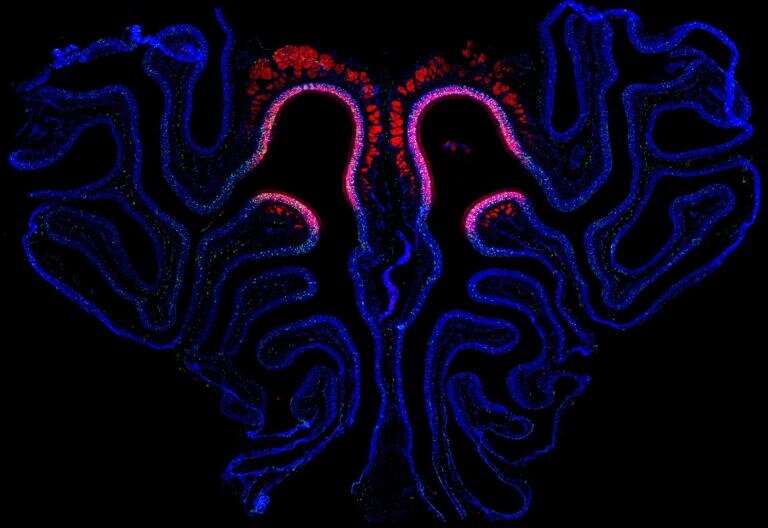This article has been reviewed according to Science X's editorial process and policies. Editors have highlighted the following attributes while ensuring the content's credibility:
fact-checked
trusted source
proofread
Researcher working on ways to restore a lost sense of smell

Take a moment to appreciate your sense of smell. It helps you savor everything you eat, from fresh-baked cookies to just-picked strawberries. It alerts you to spoiled food, natural gas leaks, and fires. And yet, it's likely that you take it for granted. Unless, that is, you've lost it.
Anosmia—the inability to smell—became more common during the COVID-19 pandemic, when many people who caught the virus lost their ability to smell, usually temporarily. Yet there have always been people with anosmia. Sometimes the loss happens suddenly, due to blunt trauma or a viral infection. Most commonly, however, it happens gradually as part of the aging process.
"Probably over half of the elderly population in the United States has decreased sense of smell, but they don't notice it because it's very gradual," says Brian Lin, GBS 17, a research assistant professor of developmental, molecular and chemical biology at Tufts University School of Medicine.
Just because the loss is invisible and, in some cases, unnoticed, doesn't mean it's not a problem. Anosmia causes a decreased ability to taste food, which can lead to unhealthy weight loss in the elderly. It can put people in danger when, for example, they don't realize a pan with food is burning on the stove. There is also an association between anosmia and depression, with more than a quarter of those who've lost their sense of smell reporting depression.
Lin is working on ways to deepen our understanding of anosmia and to develop ways of treating it, along with his mentor James Schwob, the George A. Bates Professor of Histology and professor of developmental, molecular and chemical biology at Tufts School of Medicine. Lin earned his Ph.D. in Schwob's lab at the Graduate School of Biomedical Sciences and the two continue to work closely together in the lab.
Lin was set on becoming a cancer researcher until he did a rotation in Schwob's lab as a graduate student. "First, I realized the olfactory tissue itself is beautiful and has such a complex structure," he says. "And I realized so many things are based on the sense of smell. Most of what people call taste is really smell. I'm a foodie and it would be catastrophic if I could not taste food properly."
Olfactory tissue contains a layer of neurons with long arms that reach down into the nasal cavity and another set of long arms that reach up into our brains. The arms in the nasal cavity sense the various molecules coming from, say, a pan on the stove, and the arms in the olfactory part of our brains deliver the sensory information so we can decide if it's chicken soup or clam chowder.
Olfactory neurons die on a regular basis, and there is a specific set of stem cells whose job it is to make new ones. As we age, these stem cells weaken, in a process scientists call "neural exhaustion." The result? Dying neurons are not replaced as regularly and the sense of smell fades away.
Something different happens in sudden anosmia. Sometimes it's related to inflammation from illness; when inflammation subsides, smell returns. Sometimes it's caused by trauma that damages all the neurons at once. In that case, a different set of olfactory stem cells, which are usually quiet, "wake up" and recreate the tissue necessary for smell, including new neurons.
"In neural exhaustion, the quiet stem cells, called HBCs, never wake up," Lin says. "If you can find a way to wake them up, you could recreate tissue from scratch."
Schwob thinks he's found a way to do just that.
He and colleagues have developed and patented an approach that he hopes will one day be used to restore smell. His approach uses a type of RNA molecule to switch off a particular gene. Switching it off is the signal for the HBC cells to spring into action and recreate olfactory tissue.
The RNA molecule is a type of microRNA, which are short pieces of RNA found naturally in the body that adjust the function of genes like a dimmer switch—on, off, or somewhere in between. Therapeutics using microRNA are already approved by the FDA to treat high cholesterol and certain rare diseases.
Schwob has demonstrated that applying the microRNA to olfactory tissue in animals works to regenerate the tissue, and he has preliminary positive data from human cell cultures in the lab.
In separate but related work, Lin is attempting to build a better lab-based model of human olfactory tissue. Right now, the only way to grow human olfactory cells in the lab is to grow the different cell types separately on flat surfaces submerged in solution. "That's not realistic," Lin says. "We're trying to have something that looks more like tissue."
He is aiming to create a model called an organoid that would consist of a spheroidal mass of olfactory tissue in the air, with integrated layers of all the different cell types.
Organoids make pre-clinical trial research quicker, less expensive, and potentially more effective than using animals or currently available human cell cultures. Organoids have already been developed for lungs, kidneys, and other organs, but not for olfactory tissue. "If you had a proper organoid," Schwob says, "that would be a powerful way to get to the point of knowing how effective a drug would be in a clinical setting." In fact, the organoid could be used for further tests of Schwob's therapy for anosmia.
An organoid would also allow more research into all types of questions related to smell, loss of smell, and olfactory tissue. "Having a robust and efficient organoid would be game-changing for the entire field," Lin says.















